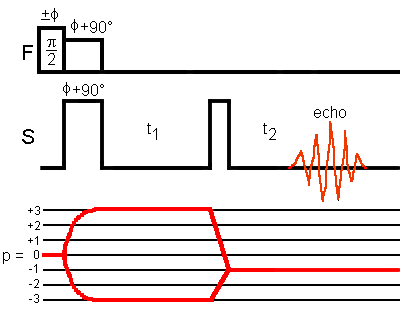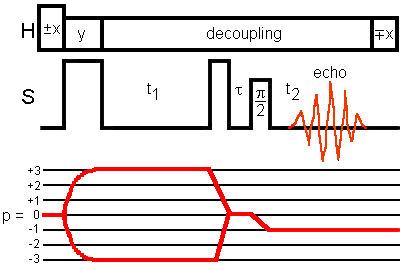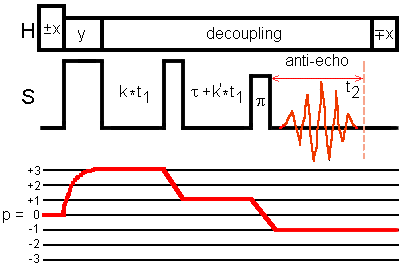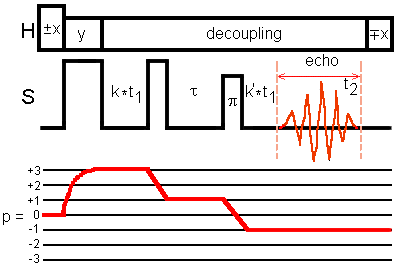Multiple Quantum Cross Polarization MQ-MAS
MQ-CP experiments allow editing of high-resolution spectrum.
Lim and Grey investigated MQ-CP experiment, in which S-spin MQ coherences are created directly by cross-polarization from the fluor and then correlated with single-quantum coherences in a 2D MQMAS experiment.

This figure represents the 3Q-CP with (amplitude-modulated) two-pulse experiment, which should not generate pure absorption 2D lineshape because the coherence transfer pathways are not symmetric.
ACQUISITION: Hyper-complex or TPPI
Shearing transformation is required to obtain 2D isotropic (in F1 dimension) anisotropic (in the F2 dimension) correlation spectrum.
Ashbrook and coworkers proposed various methods for MQ-CP experiments, in which S-spin MQ coherences are created directly by cross-polarization from the proton and then correlated with single-quantum coherences in a 2D MQMAS experiment.
First method

This figure represents 3Q-CP with (amplitude-modulated) z-filter experiment where p = ±3 coherences are excited from the p = 0 coherence created by the cross-polarization.
The 'flip-back' pulse aids the recovery of the proton equilibrium magnetization.
Amplitude-modulated experiment should generate pure absorption 2D lineshape.
ACQUISITION: Hyper-complex or TPPI
Shearing transformation is required to obtain 2D isotropic (in F1 dimension) anisotropic (in the F2 dimension) correlation spectrum.
Second method

This figure represents the phase-modulated split-t1 experiment where p = +3 coherence is excited from the p = 0 coherence created by the cross-polarization.
Phase cycling ensures that only the p = +3 coherence is selected after the spin-locking period.
The 'flip-back' pulse aids the recovery of the proton equilibrium magnetization.
The single-quantum k'*t1 evolution period is before the final pulse. The anti-echo signal is detected. This is the case for the triple-quantum coherence of a spin I = 3/2 nucleus.
ACQUISITION: F1-QF
Shearing transformation is avoided.
Third method

This figure represents the phase-modulated split-t1 experiment where p = +3 coherence is excited from the p = 0 coherence created by the cross-polarization.
Phase cycling ensures that only the p = +3 coherence is selected after the spin-locking period.
The 'flip-back' pulse aids the recovery of the proton equilibrium magnetization.
The single-quantum k'*t1 evolution period is after the final pulse. The echo signal is detected. This is the case for the triple-quantum coherence of a spin I = 5/2, 7/2 or 9/2 nucleus.
ACQUISITION: F1-QF
Shearing transformation is avoided.
